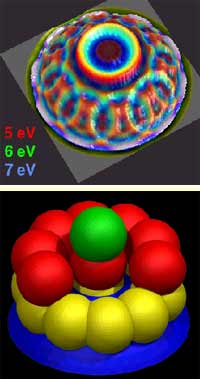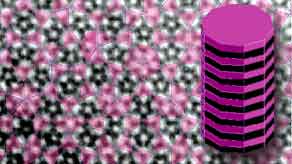| BERKELEY, CA — An
international team of scientists has demonstrated that the electronic
states of the strange metal alloys known as quasicrystals are more like
those of ordinary metals than theorists believed possible.
Eli Rotenberg, a staff scientist at the Advanced Light Source (ALS) at
the Department of Energy's Lawrence Berkeley National Laboratory, Karsten
Horn of the Fritz-Haber Institute, Max-Planck Society, Berlin, and their
colleagues investigated the electronic structure of a quasicrystalline
alloy of aluminum-nickel-cobalt (AlNiCo) by means of angle-resolved
photoemission. They report their findings in the August 10 issue of the
journal Nature.
 |

THE CONSTANT ENERGY CONTOURS FOR NEARLY FREE S-P ELECTRONS IN
AlNiCo QUASICRYSTALS (DATA, TOP) ARE DERIVED FROM THREE-DIMENSIONAL
SPHERES DISTRIBUTED APERIODICALLY IN MOMENTUM SPACE (MODEL, BOTTOM).
|
They found that rather than moving around arbitrarily, electrons in
quasicrystals travel in "bands" with distinct momentum and
energy. The data show that electron momenta and energies are correlated
with the structure of the quasicrystal.
Band-like properties, common in metals and other ordinary crystals,
were not expected in quasicrystals. But then quasicrystals themselves are
an unexpected phenomenon.
"Before quasicrystals were discovered by Dan Schechtman and his
colleagues in 1984, most people would have said they were structurally
impossible," says Rotenberg. "You can tile a plane with
equilateral triangles or squares -- shapes with three-fold or four-fold
rotational symmetry -- and you can fill space periodically with
tetrahedrons or cubes, which are two of the ways that atoms are typically
arranged in ordinary crystals. But you can't tile a plane with pentagons
-- not without leaving gaps -- and you can't fill space with
dodecahedrons."
Yet, although quasicrystals display five-fold symmetry and other
"forbidden" symmetries locally, they still possess perfect
long-range structural order. So complex is their geometry that it has
taken years to understand how their long-range atomic structures could
arise.
Other investigations have centered on potentially useful properties.
Quasicrystalline alloys are durable, stable at high temperatures, and make
excellent nonstick coatings -- and they can store hydrogen at high
density.
Though they are composed of excellent electrical conductors such as
aluminum and copper, quasicrystalline alloys themselves are extremely
resistive -- the more perfect the quasicrystal, the more resistive it
becomes. At low temperatures their resistance changes markedly in response
to changing magnetic fields, which makes them interesting for applications
in magnetic devices.
"But few experiments have been done on the basic properties of
their electronic states," says Rotenberg. "In other words, where
are the electrons and how do they move? These were unresolved
questions."
Ordinary metals are good conductors because their valence electrons can
move freely from atom to atom; this freedom is facilitated by long-range
periodic structure. Since quasicrystals lack periodic structure, theorists
expected no such extended electronic states.
"One might imagine that from an electron's point of view the
material appears disordered. If so, the electronic states would be
confined to localized clusters," Rotenberg says, and indeed,
theoretical considerations suggested electronic states confined to the
quasicrystal's many different local structures.
 |

IN THE PLANE, THE AlNiCo QUASICRYSTAL, WHICH CONSISTS OF
OVERLAPPING DECAGONS, IS APERIODIC. BUT THE STACKED PLANES
HAVE PERIODIC STRUCTURE.
Images by Steinhardt and Jeong, Nature 382,
433-5
|
Rotenberg, Horn, and their colleagues decided to test the prediction
with a special kind of quasicrystal, an AlNiCo alloy consisting of stacked
planes of atoms exhibiting ten-fold symmetry. By looking at the behavior
of electrons in the plane, they could observe the effects of this
quasicrystalline ordering; by looking at right angles to the planes, they
could observe the effects of the periodic, crystalline-like ordering of
the stack.
Peter Gille of the Ludwig-Maximilians-University, Munich, grew the
quasicrystal, and the samples were prepared and characterized by Horn and
by Wolfgang Theis of the Free University of Berlin. At the ALS, Rotenberg,
Horn, and Theis examined the samples by means of low-energy electron
diffraction and by angle-resolved photoemission at beamline endstation
7.0.1.2.
"We measure the emission angles and the kinetic energy of
electrons scattered from near the surface of the material by soft x
rays," says Rotenberg. "These are the valence electrons, not as
tightly bound as electrons near the atomic cores."
The sample is rotated to get a complete distribution of electron angles
and energies. The eventual result is a plot of the electronic states of
AlNiCo's valence electrons in "momentum space," the mathematical
space in which such fundamental concepts as Fermi surfaces and Brillouin
zones are constructed and on which much of the band theory of solids is
based.
"Our principal findings were that the distribution of the
electronic states in momentum space correlates with the electron
diffraction pattern, just like in an ordinary crystal. The electrons
aren't localized to clusters, instead they feel the long-range
quasicrystal potential," Rotenberg says.
"We found that the electrons propagate nearly freely, like
conduction electrons in an ordinary metal," he continues, "and
we found there is a Fermi surface, crossed by nickel and cobalt
d-electrons; its topology should determine some of the material's
fundamental properties."
The discoveries open many new avenues for inquiry, Rotenberg says.
"How can we relate our observations to unusual properties such as
high resistivity? And are there any localized electrons in addition to the
delocalized electrons we found that look so 'ordinary?'"
"Quasicrystalline valence bands in decagonal AlNiCo," by Eli
Rotenberg, Wolfgang Theis, Karsten Horn, and Peter Gille appears in Nature,
10 August 2000.
The Berkeley Lab is a U.S. Department of Energy national laboratory
located in Berkeley, California. It conducts unclassified scientific
research and is managed by the University of California.
|

